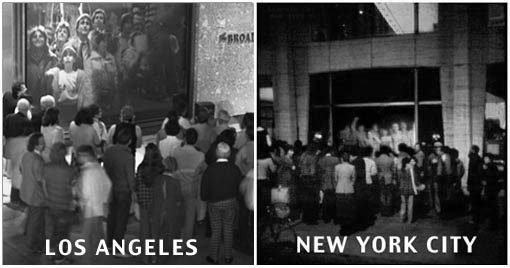
“Welcome to Electronic Cafe International” was a fascinating piece of reading, documenting the work of Kit Galloway and Sherrie Rabinowitz and their seminal work, Hole-in-Space from 1980. It discussed greatly on the effects of the artwork on the people that had interacted with it and how their behavior changed after the event.
I found the artwork by Kit Galloway and Sherrie Rabinowitz an inspiration to our current society where social media dominated our daily life. It reminded us that social media could still be used for good. From the reading, it could clearly be seen that Hole-in-Space were one of the few early works(including the Videofreex) that experimented with the virtual space or what we know today as the “third space”.
There’s a quote from the reading that I would like to bring up as it would help with the research.
A virtual space creates social situation without traditional rules of etiquette. The absence of the threat of physical harm makes people braver.
I could not agree more with the reading. As society was often bound by rules and social norms, we could not always act or speak out what was on our mind, because we too were bounded by those restrictions. It acts as an invisible rope binds us to our roles and allowed us to function as a society. However, the “third space” removes all those restrictions and allow us to truly act and experiment. It allows creativity to flourish and interactions from different races to mingles and forge greater social bonds. An example that the reading gave was the Korean and the Black community was used to be each other’s enemy but after the artwork, the relationships between the two community improved greatly. This could never be achieved anywhere but through the “third space”.
The reading was closely related to our next week(week4) lesson on our social engagement with one another and how the “thirds space” invented new ways for us to interact. Hole-in-Space by Kit Galloway and Sherrie Rabinowitz should also be considered as a collective narrative, as it documented how a group of people behavior in front of the “hole”. It made us rediscover ourselves under a different light.
In conclusion, I have learned a great deal about the “third space” and how closely related it is to our behavior. It has proven time and time again that we are still not familiar with ourselves, but only through the “third space” can we safely experiment and understand a little more about us.

I too agree with you that the “third space” removes all those restrictions which is put in place by society. I feel that having able to let ourselves loose in the “third space” allows us to feel comfortable while using social media which decreases our scepticism towards new and emerging communication technologies.
Cher See, interesting thoughts on the third space and how we can engage it and explore it for artistic purposes. And yes, from the quote you selected, there are no rules, or perhaps a new set of rule that define and propel our actions in the third space environments. What is missing from your essay is specifics: you should describe Hole in Space, how it worked, how it connected audiences in New York and Los Angeles, how people responded, specifically with emotion and excitement, and perhaps explain why they had that kind of positive experience. You touched on many larger concepts, but it is also very important to flesh out the details and describe what you saw and heard when you viewed the piece.
Yes, I definitely agree that the third space provides us a new dimension without rules and etiquette, allowing us to act our true selves. It encourages us to be fearless and more experimental in our interactions with others, as the third space only features an “extension” of ourselves. The Hole-In-Space was an installation that came as a surprise to the public, and as one of the newest forms of technology at the time. The work was approached with genuine curiosity and the social interactions made through it was perhaps the most authentic. I liked how you mentioned how the relationships between the Koreans and Blacks improved specifically from this type of interactions.
Today, our identity on the third space seems to have evolve quite a bit, as we hold the power to reconstruct ourselves on the net. The freedom that the Internet provides also opened doors to fake identities, malicious intentions and anonymous hacking. Do you think the change in our behaviour is influenced by the informality of the third space?